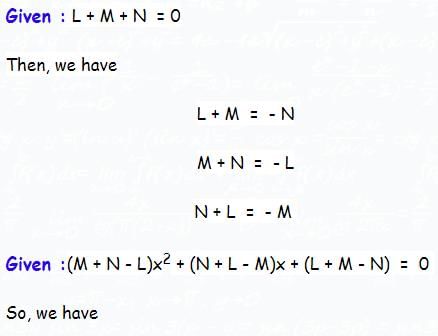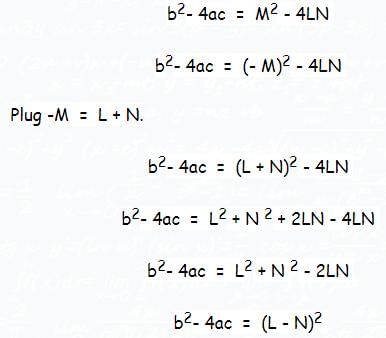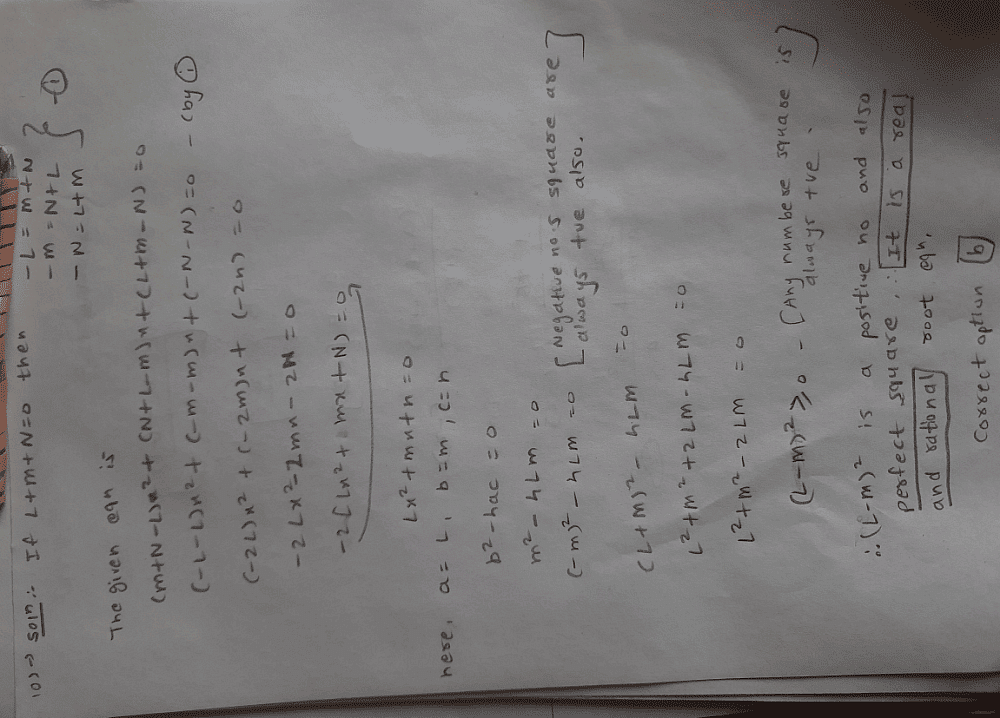CA Foundation Exam > CA Foundation Questions > If L + M + N = 0 and L M N are rationals the ...
Start Learning for Free
If L + M + N = 0 and L M N are rationals the roots of the equation (M+N–L) x2 + (N+L–M)x + (L+M–N) = 0 are
- a)real and irrational
- b)real and rational
- c)imaginary and equal
- d)real and equal
Correct answer is option 'B'. Can you explain this answer?
| FREE This question is part of | Download PDF Attempt this Test |
Verified Answer
If L + M + N = 0 and L M N are rationals the roots of the equation (M+...



Because b^2-4ac > 0 and also a perfect square, the roots are real and rational.
Most Upvoted Answer
If L + M + N = 0 and L M N are rationals the roots of the equation (M+...
Given information
• L M N = 0
• L M N are rationals
To find
• The nature of roots of the equation (M NL) x2 (N LM)x (L MN) = 0
Solution
Let's assume α and β be the roots of the given equation.
Sum of roots = - (N LM)/ (M NL) = -N/M
Product of roots = (L MN)/ (M NL) = N/L
Using these values, we can write the quadratic equation as:
x2 - (sum of roots) x + (product of roots) = 0
x2 + (N/M)x + (N/L) = 0
Now, we need to check the nature of roots of the quadratic equation.
Discriminant = b2 - 4ac
= (N/M)2 - 4(N/L)(L/M)
= (N2/M2) - 4(N2/LM)
= N2(1/M2 - 4/LM)
As we know that L M N = 0, which implies that at least one of the value should be zero.
Let's consider the possibilities:
• If L = 0, then the equation will become x2 = 0, which will have only one real and rational root, i.e., x = 0. But in the given equation, L MN ≠ 0, which means L cannot be zero.
• Similarly, we can prove that M and N cannot be zero.
Hence, we can assume that L ≠ 0, M ≠ 0, and N ≠ 0.
Now, coming back to the discriminant:
N2(1/M2 - 4/LM) = N2(L - 4M)/M2L
Since L and M are rationals, their difference (L - 4M) will also be a rational number. Hence, the discriminant will be positive if and only if N2/M2L > 0. This implies that the signs of N and L should be the same.
Therefore, the possible cases are:
• If L, M, and N are all positive or all negative, then the discriminant will be positive, and the roots will be real and rational.
• If L and M are positive/negative, and N is negative/positive, then the discriminant will be negative, and the roots will be imaginary and unequal.
Hence, the correct option is (B) real and rational.
Conclusion
The nature of roots of the given equation (M NL) x2 (N LM)x (L MN) = 0 is real and rational.
• L M N = 0
• L M N are rationals
To find
• The nature of roots of the equation (M NL) x2 (N LM)x (L MN) = 0
Solution
Let's assume α and β be the roots of the given equation.
Sum of roots = - (N LM)/ (M NL) = -N/M
Product of roots = (L MN)/ (M NL) = N/L
Using these values, we can write the quadratic equation as:
x2 - (sum of roots) x + (product of roots) = 0
x2 + (N/M)x + (N/L) = 0
Now, we need to check the nature of roots of the quadratic equation.
Discriminant = b2 - 4ac
= (N/M)2 - 4(N/L)(L/M)
= (N2/M2) - 4(N2/LM)
= N2(1/M2 - 4/LM)
As we know that L M N = 0, which implies that at least one of the value should be zero.
Let's consider the possibilities:
• If L = 0, then the equation will become x2 = 0, which will have only one real and rational root, i.e., x = 0. But in the given equation, L MN ≠ 0, which means L cannot be zero.
• Similarly, we can prove that M and N cannot be zero.
Hence, we can assume that L ≠ 0, M ≠ 0, and N ≠ 0.
Now, coming back to the discriminant:
N2(1/M2 - 4/LM) = N2(L - 4M)/M2L
Since L and M are rationals, their difference (L - 4M) will also be a rational number. Hence, the discriminant will be positive if and only if N2/M2L > 0. This implies that the signs of N and L should be the same.
Therefore, the possible cases are:
• If L, M, and N are all positive or all negative, then the discriminant will be positive, and the roots will be real and rational.
• If L and M are positive/negative, and N is negative/positive, then the discriminant will be negative, and the roots will be imaginary and unequal.
Hence, the correct option is (B) real and rational.
Conclusion
The nature of roots of the given equation (M NL) x2 (N LM)x (L MN) = 0 is real and rational.
Free Test
FREE
| Start Free Test |
Community Answer
If L + M + N = 0 and L M N are rationals the roots of the equation (M+...

Attention CA Foundation Students!
To make sure you are not studying endlessly, EduRev has designed CA Foundation study material, with Structured Courses, Videos, & Test Series. Plus get personalized analysis, doubt solving and improvement plans to achieve a great score in CA Foundation.

|
Explore Courses for CA Foundation exam
|

|
Similar CA Foundation Doubts
If L + M + N = 0 and L M N are rationals the roots of the equation (M+N–L) x2 + (N+L–M)x + (L+M–N) = 0 area)real and irrationalb)real and rationalc)imaginary and equald)real and equalCorrect answer is option 'B'. Can you explain this answer?
Question Description
If L + M + N = 0 and L M N are rationals the roots of the equation (M+N–L) x2 + (N+L–M)x + (L+M–N) = 0 area)real and irrationalb)real and rationalc)imaginary and equald)real and equalCorrect answer is option 'B'. Can you explain this answer? for CA Foundation 2024 is part of CA Foundation preparation. The Question and answers have been prepared according to the CA Foundation exam syllabus. Information about If L + M + N = 0 and L M N are rationals the roots of the equation (M+N–L) x2 + (N+L–M)x + (L+M–N) = 0 area)real and irrationalb)real and rationalc)imaginary and equald)real and equalCorrect answer is option 'B'. Can you explain this answer? covers all topics & solutions for CA Foundation 2024 Exam. Find important definitions, questions, meanings, examples, exercises and tests below for If L + M + N = 0 and L M N are rationals the roots of the equation (M+N–L) x2 + (N+L–M)x + (L+M–N) = 0 area)real and irrationalb)real and rationalc)imaginary and equald)real and equalCorrect answer is option 'B'. Can you explain this answer?.
If L + M + N = 0 and L M N are rationals the roots of the equation (M+N–L) x2 + (N+L–M)x + (L+M–N) = 0 area)real and irrationalb)real and rationalc)imaginary and equald)real and equalCorrect answer is option 'B'. Can you explain this answer? for CA Foundation 2024 is part of CA Foundation preparation. The Question and answers have been prepared according to the CA Foundation exam syllabus. Information about If L + M + N = 0 and L M N are rationals the roots of the equation (M+N–L) x2 + (N+L–M)x + (L+M–N) = 0 area)real and irrationalb)real and rationalc)imaginary and equald)real and equalCorrect answer is option 'B'. Can you explain this answer? covers all topics & solutions for CA Foundation 2024 Exam. Find important definitions, questions, meanings, examples, exercises and tests below for If L + M + N = 0 and L M N are rationals the roots of the equation (M+N–L) x2 + (N+L–M)x + (L+M–N) = 0 area)real and irrationalb)real and rationalc)imaginary and equald)real and equalCorrect answer is option 'B'. Can you explain this answer?.
Solutions for If L + M + N = 0 and L M N are rationals the roots of the equation (M+N–L) x2 + (N+L–M)x + (L+M–N) = 0 area)real and irrationalb)real and rationalc)imaginary and equald)real and equalCorrect answer is option 'B'. Can you explain this answer? in English & in Hindi are available as part of our courses for CA Foundation.
Download more important topics, notes, lectures and mock test series for CA Foundation Exam by signing up for free.
Here you can find the meaning of If L + M + N = 0 and L M N are rationals the roots of the equation (M+N–L) x2 + (N+L–M)x + (L+M–N) = 0 area)real and irrationalb)real and rationalc)imaginary and equald)real and equalCorrect answer is option 'B'. Can you explain this answer? defined & explained in the simplest way possible. Besides giving the explanation of
If L + M + N = 0 and L M N are rationals the roots of the equation (M+N–L) x2 + (N+L–M)x + (L+M–N) = 0 area)real and irrationalb)real and rationalc)imaginary and equald)real and equalCorrect answer is option 'B'. Can you explain this answer?, a detailed solution for If L + M + N = 0 and L M N are rationals the roots of the equation (M+N–L) x2 + (N+L–M)x + (L+M–N) = 0 area)real and irrationalb)real and rationalc)imaginary and equald)real and equalCorrect answer is option 'B'. Can you explain this answer? has been provided alongside types of If L + M + N = 0 and L M N are rationals the roots of the equation (M+N–L) x2 + (N+L–M)x + (L+M–N) = 0 area)real and irrationalb)real and rationalc)imaginary and equald)real and equalCorrect answer is option 'B'. Can you explain this answer? theory, EduRev gives you an
ample number of questions to practice If L + M + N = 0 and L M N are rationals the roots of the equation (M+N–L) x2 + (N+L–M)x + (L+M–N) = 0 area)real and irrationalb)real and rationalc)imaginary and equald)real and equalCorrect answer is option 'B'. Can you explain this answer? tests, examples and also practice CA Foundation tests.

|
Explore Courses for CA Foundation exam
|

|
Suggested Free Tests
Signup for Free!
Signup to see your scores go up within 7 days! Learn & Practice with 1000+ FREE Notes, Videos & Tests.
























